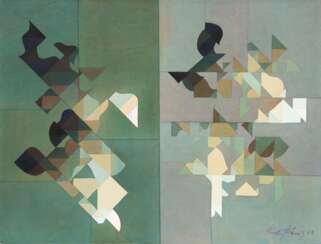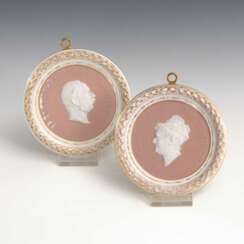emmerich

Kurt Kranz was a German artist of the Bauhaus school, graphic artist and university professor.
Kranz studied as a lithographer, then at the Bauhaus Dessau, taking courses with Paul Klee and Wassily Kandinsky. In 1950 he accepted a position at the Hamburg University of Fine Arts and remained there until 1972. He visited America and Japan as a guest lecturer, including Harvard University in Cambridge, USA.
Kurt Kranz remained faithful to the ideas of the Bauhaus throughout his life, was able to experiment freely and boldly with photography and photomontage, used a variety of photographic techniques and created some of the most striking series of abstract images to emerge from the Bauhaus.


Kurt Kranz was a German artist of the Bauhaus school, graphic artist and university professor.
Kranz studied as a lithographer, then at the Bauhaus Dessau, taking courses with Paul Klee and Wassily Kandinsky. In 1950 he accepted a position at the Hamburg University of Fine Arts and remained there until 1972. He visited America and Japan as a guest lecturer, including Harvard University in Cambridge, USA.
Kurt Kranz remained faithful to the ideas of the Bauhaus throughout his life, was able to experiment freely and boldly with photography and photomontage, used a variety of photographic techniques and created some of the most striking series of abstract images to emerge from the Bauhaus.


Hans Hofmann, a German-American painter, stands as a towering figure in the 20th-century art world, celebrated for his vibrant contributions to abstract expressionism. Born in Germany in 1880, Hofmann's journey in art took him across continents, from Europe to the United States, where his innovative teaching methods and bold, color-filled canvases left an indelible mark on generations of artists. His unique approach to painting, characterized by a dynamic interplay of color and form, helped bridge the gap between the European modernist traditions and the emerging American abstract art scene.
Hofmann's work is distinguished by its intense color palettes and the technique he termed "push and pull," which refers to the careful balance of color and shape to create depth and movement within the canvas. This technique not only showcased his mastery over the medium but also influenced the development of abstract expressionism, making Hofmann a pivotal figure among his contemporaries. His paintings, such as "The Gate" (1959-60), exemplify this approach and are celebrated in prestigious museums worldwide, including the Museum of Modern Art in New York and the San Francisco Museum of Modern Art.
Beyond his personal contributions as an artist, Hofmann was an esteemed educator, guiding the next generation of artists through his schools in New York and Provincetown. His teaching philosophy emphasized the importance of understanding the fundamental elements of art—color, form, and space—and their interrelation, which he believed was key to achieving harmony and expression in painting.
For collectors and experts in art and antiques, Hans Hofmann's works represent not just significant artistic achievements but also valuable pieces of cultural history. His paintings and teachings continue to inspire and influence the art world, making his pieces highly sought after in galleries and auctions.
We invite you to sign up for updates on new product sales and auction events related to Hans Hofmann. This subscription is your gateway to owning a piece of art history, ensuring you're informed of the latest opportunities to add to your collection. Join us in celebrating the legacy of a master whose work transcends time and continues to dazzle the art world.


Ellen Frankenthaler was an American painter renowned for her pivotal role in the development of the Color Field movement. Born in 1928, her innovative approach to painting involved soaking her canvas in paint, a technique that led to her being celebrated for her ability to merge color and form in a way that was both expressive and deeply personal. This method, often referred to as "soak-stain," allowed her to achieve a luminosity and depth in her works that was previously unseen, setting her apart from her contemporaries and making her a key figure in post-war American art.
Frankenthaler's influence extends beyond her unique technique; her work is a testament to the power of abstraction and its ability to evoke emotion without relying on representational forms. Her paintings, characterized by their bold use of color and fluid shapes, invite viewers to interpret them in their own way, making her art accessible to a broad audience. Her significant contributions to the art world are recognized in the collections of major museums and galleries worldwide, including the Museum of Modern Art and the National Gallery of Art.
For collectors and experts in art and antiques, Ellen Frankenthaler remains a symbol of innovation and creativity. Her works not only enrich private collections but also continue to inspire new generations of artists. For those interested in exploring the depth of Frankenthaler's impact on culture, art, and painting, subscribing for updates on new product sales and auction events related to her work is an invaluable opportunity. This subscription ensures that enthusiasts are always informed about the latest opportunities to engage with Frankenthaler's enduring legacy.

Samuel Lewis Francis, an American painter and printmaker, was known for his pivotal role in postwar American painting and his contributions to the Abstract Expressionism and Color Field painting movements. Born in San Mateo, California, Francis' early life was marked by a deep personal loss and a significant injury during his service in the Army Air Corps, which led him to pursue painting while recovering in a hospital. His work, characterized by splashes of bright contrasting colors against expansive white canvases, drew international acclaim, particularly in Europe and Japan, underscoring his influence on the global art scene.
Francis' art evolved through various phases, from monochromatic works to vibrant, large-scale pieces, and was deeply influenced by his time in Paris and Japan, reflecting elements of Tachisme and possibly Zen Buddhism. Notable for creating large murals and his "Edge" series, Francis also founded The Lapis Press, further contributing to the art community by producing visually compelling texts. Despite facing health challenges towards the end of his life, he remained prolific, leaving behind a legacy celebrated through the Sam Francis Foundation, which aims to perpetuate his creative legacy.
Francis' artworks are held in prestigious collections worldwide, including The Metropolitan Museum of Art, The Museum of Modern Art, New York, and the Centre Pompidou-Musee National d'Art Moderne, Paris, highlighting his enduring influence on contemporary art. His auction records and continued recognition in solo exhibitions posthumously underscore the lasting impact of his work on both collectors and the art community.
For those passionate about modern art and its history, staying informed about Samuel Lewis Francis' contributions and the ongoing exhibitions of his works can be enriching. Sign up for updates related to Francis to ensure you don't miss out on new sales and auction events showcasing his vibrant legacy.


Adolf Gottlieb was an American abstract expressionist painter, sculptor and printmaker.


Ben Nicholson, an English artist, is celebrated for his significant contributions to abstract art. Born into an artistic family, Nicholson's work evolved from figurative art to embrace and lead in the development of abstract art in Britain. His early career was marked by experimentation with Cubism and interaction with influential artists like Barbara Hepworth, Henry Moore, Piet Mondrian, and Pablo Picasso, which profoundly shaped his artistic direction.
Nicholson's art is notable for its sensitive balance of tone and texture, employing dynamic and rhythmic lines that abstractly reference architectural forms and societal structures. His technique involved meticulous carving, painting, and the innovative use of color, especially in his later works where he explored the interplay of light and form to create poetic, abstract landscapes. His contributions were not just confined to his own practice; through collaborative projects and influential writings, he played a pivotal role in the discourse of modernist art, advocating for abstract art's broader appreciation.
Noteworthy pieces of Nicholson's work, including "March 1963 (Archimedes)" and "June 1961 (green goblet and blue square)," among others, are housed in prestigious collections like the Tate Gallery, Tate St Ives, Kettle's Yard Art Gallery in Cambridge, The Hepworth Wakefield, Pallant House Gallery in Chichester, and the Pier Arts Centre in Stromness, Orkney.
Nicholson's legacy as a pioneer of abstract art in the UK is secured through his innovative approaches and influential partnerships, which have left an indelible mark on the landscape of 20th-century art. His work continues to inspire and resonate, reflecting a deep understanding of the abstract's power to express the complexities of human experience and the natural world.
For collectors and experts in art and antiques interested in the pivotal movements of 20th-century art, Ben Nicholson's oeuvre offers a rich field of study and appreciation. To stay updated on new product sales and auction events related to Ben Nicholson's work, signing up for updates is a step towards deepening your understanding and appreciation of this key figure in modernist art.















































































